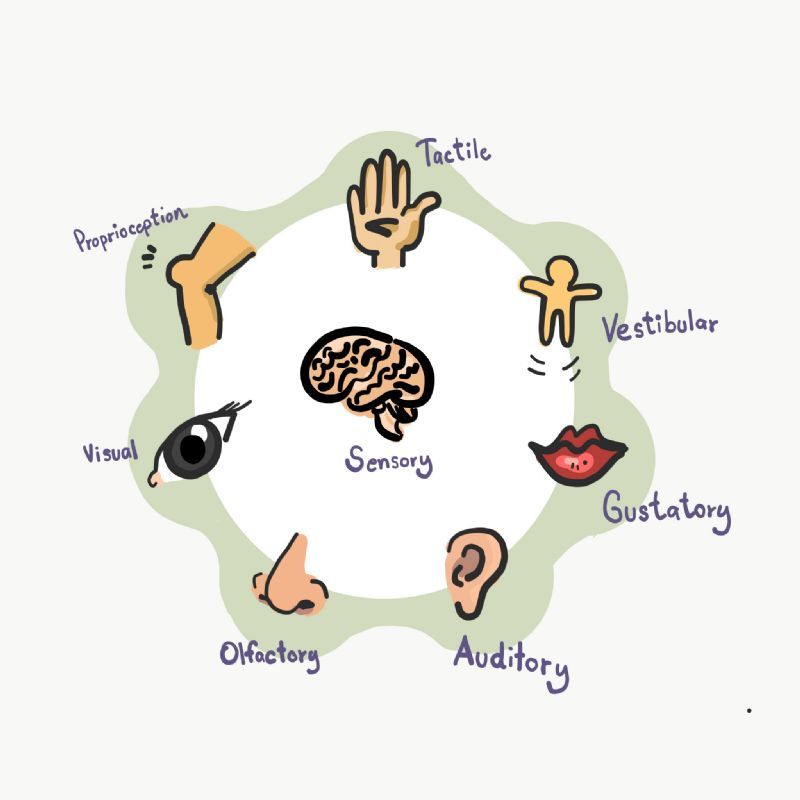 Written by Megan Smith, PT
Written by Megan Smith, PT
Often confused with autism spectrum disorder, sensory processing disorder, which is also known as SPD, is a term often used by OTs, pediatricians, and other healthcare professionals. Although not yet a diagnosis found in the DSM-5, one in six children experience sensory processing difficulties but are not on the spectrum. We invite you to read further to understand better the complexities of ASD and SPD and how to ensure children struggling with sensory issues receive appropriate treatment, such as multi-sensory therapy.

Because most children diagnosed with autism also display symptoms related to sensory processing disorder, it can be difficult for parents to know if their child has both disorders or just ASD or SPD alone. Sensory issues can also be present as a comorbid condition of different disorders, such as ADHD, anxiety, OCD, PDD, and other developmental coordination disorders. As a common characteristic in many developmental behavioral disorders, difficulties with tolerating or processing sensory information can vary as far as the cause, effects, and appropriate treatment.
Sensory processing disorder is generally considered to be a dysfunction in the brain’s ability to process sensory stimuli, often resulting in sensory overload joined by either hyposensitivity or hypersensitivity. Although these conditions overlap in multiple ways, proper diagnosis is required to find the most effective treatment plan for every child’s unique requirements.
While children on the autism spectrum tend to be the most affected by sensory symptoms, those with SPD also demonstrate more sensory challenges than children with typical development. Validated standardized testing, such as the Sensory Profile, the Pediatric Evaluation of Disability Inventory (PEDI), and several other diagnostic tools for measuring sensory processing can help to determine the appropriate treatment plan and check for other disorders, such as anxiety, PDD, and ADHD.

Because the symptoms and signs of sensory processing disorder and autism are similar, treatments are often applied to address both disorders simultaneously. Sensory integration and multisensory therapy applied by occupational therapists are tailored to meet your child’s specific stimulation needs. However, kids on the autism spectrum often require additional treatment modalities such as speech therapy and behavioral therapy. Early diagnosis is crucial for both disorders, resulting in more effective intervention and treatment so every child can reach their full potential.
| AAC Lite Tech Evaluation Kit View Product |
Utilizing both medical and clinic-based sensory interventions, OTs and other healthcare professionals often utilize tools that the parent can also use at home with their child. While therapy under the guidance of a professional therapist is recommended, that guidance can extend to include specific multisensory tools the child can use at home, at school, and play.
~3.webp&newwidth=365&maxheight=200) | Multi-Sensory Environment Starter Packs View Product |
Believed to organize the sensory system, sensory-based therapies provide customizable input that benefits vestibular, proprioceptive, auditory, and tactile functionality. Brushing, massage, therapeutic swings, textured balls, and weighted blankets are just a few examples of the tools and activities used for sensory integration therapy, along with the sensory-focused environmental modification employed in multisensory rooms.
 | Wilbarger Bristle Brush for Tactile Stimulation View Product |
Using sensory integration and praxis tests, pediatricians and OTS can diagnose sensory processing disorder, while autism is typically diagnosed via behavioral observation and developmental history. Because both disorders can be challenging to identify, it’s important to regularly monitor your child and have them checked periodically by a pediatrician.
| Stimulating Sensory Kit View Product |
Obtaining a thorough evaluation is highly recommended before starting any kind of treatment, along with setting clear treatment goals. Developmental milestone checklists can help parents with the early identification of autism and other developmental impairments so children and families can get the services and support they need.
| Therapeutic Balls Sensory Motor Developmental Kit View Product |
Even though neither autism spectrum disorder nor sensory processing disorder is directly treatable through medication, some of the symptoms that both conditions cause may be alleviated at least in part by using specific pharmaceuticals. Stimulants and other drugs are often used to counteract hyperactivity, antidepressants may help anxiety along with mood instability, while antipsychotic medications may be used to treat severe behavioral issues.
 | Kids' Sensory Toys for Motor Development, 32 Pieces, for In-Clinic or Home Use, Snoezelan Sensory Satchel by School Speciality View Product |
Generally appearing between the ages of 1 and 3, symptoms of ASD and SPD can present both gradually or suddenly. Autism has a wide range of early warning signs, with a delay/lack of joint attention, language delays/differences, and the regression of developmental milestones and skills being the most common. Early warning signs for sensory processing disorder include extreme sensitivities or insensitivities to sensory stimuli, causing children to overreact or underreact in non-typical ways.
 | Multi Sensory Stimulating Shelf Kit View Product |
As a critical aspect of well-being throughout our life span, sensory processing is the bridge between physical and mental health. When children experience challenges processing the sensory information they’re getting from the world around them, it may be a sensory processing disorder holding them back. While the majority of kids on the autism spectrum also have SPD, not all children with SPD have autism. Although it’s connected with childhood anxiety, ADHD, and other disorders, sensory processing disorder can also occur without any other diagnosis.
Thanks for reading this article about the differences between autism and sensory processing disorder and be sure to check out more of our educational articles at Caregiver University. You can also find a wide range of multi-sensory tools at Rehabmart to encourage healthy sensory integration for your child.

Megan has been a part of Rehabmart since its inception nearly 20 years ago. For the past several years she has been enjoying her role as HR Director while maintaining her Physical Therapy license. When she isn't working on her next in-service or working to find a new team member, she enjoys her five children, helping those who have PT type ailments, baking, practicing yoga, and working out.